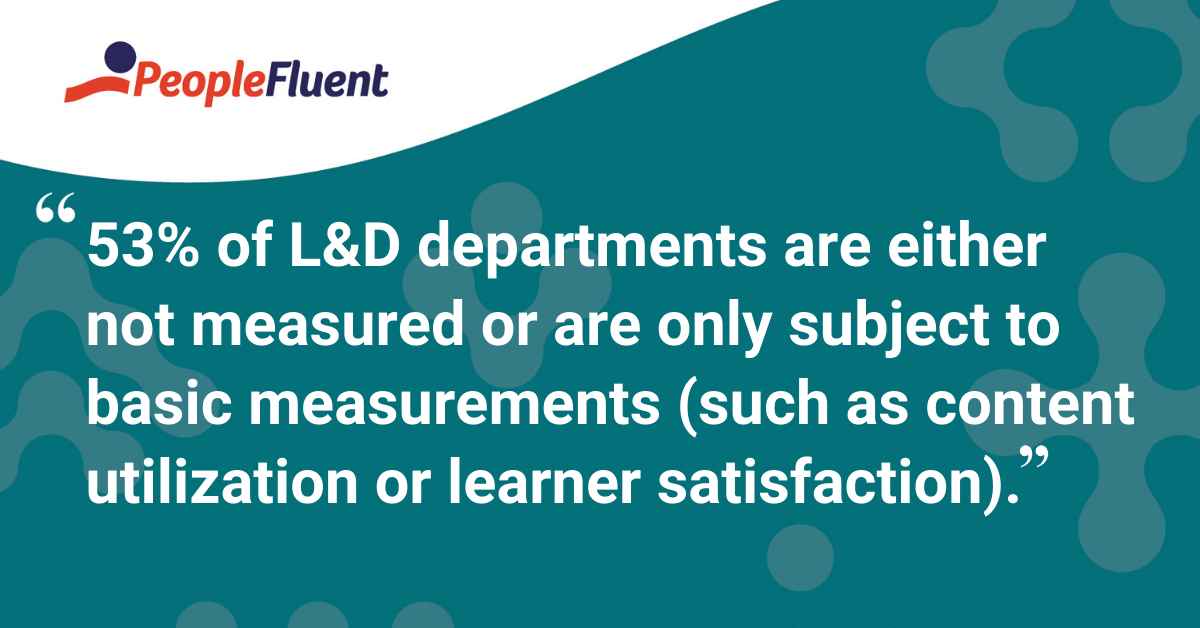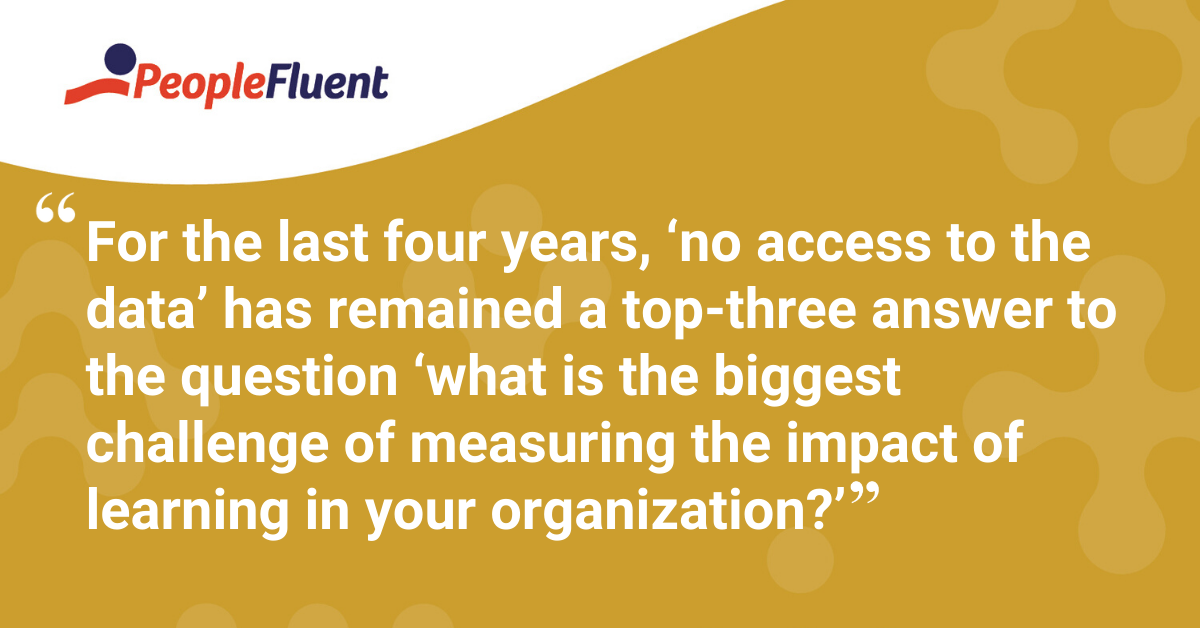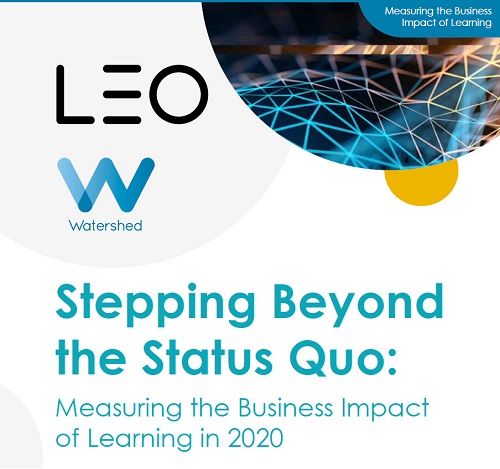Published: Feb 24, 2020Time to read: 6mins Category: Learning
Results Out: Companies Release 2020 Measuring the Business Impact of Learning Report
LEO Learning and Watershed’s measuring the business impact of learning report is now available to download. This annual survey (from our sister companies within Learning Technologies Group) measures the learning industry’s progress towards learning that is measured against business impact. With organizations having difficulty moving beyond basic measurement, we look at some key findings and opportunities from the report.
Since 2017, more than 1,300 L&D professionals have been surveyed on their approach to learning measurement in the ‘measuring the business impact of learning’ report. This year’s report looks at three key issues:
- L&D’s struggle to analyze data
- L&D’s difficulty securing stakeholder buy-in for measurement projects
- The barriers experienced inside and outside an organization when trying to get access to data.

PeopleFluent's Jeff Fissel notes that the results are interesting for anyone using, or wanting to use, a Learning Experience Platform (LXP). “One of the key strengths of an LXP is all the extra data you get on employee engagement. Users can favorite training content, create playlists of training that works for them. This is instant data on training effectiveness that can easily be related to your KPIs. The report is clear on how completion and passes aren’t enough anymore. Engagement is a more forward-thinking metric— it sheds light on whether learning is likely to stick.”
He continues: “Engagement is a precious commodity. A recent Gallup poll on employee engagement suggested that despite recent improvements, two-thirds of U.S. workers are still not fully engaged. An LXP can help measure and promote engagement by giving employees more creativity while still letting executives maintain control of who can access what and how to measure what is happening.”
While the report finds that the corporate world has proven consistent in its desire to measure the impact of its L&D investment, there has sometimes been a lack of real-world examples to back up these intentions. Therefore, the report looks at some examples of organizations implementing solutions, to accompany the issues it highlights.
Here’s a taster of the full analysis:
Problem #1: Big Data Has a Big, Business-Wide Impact, But L&D Isn’t Ready to Start Using It
Though 91% agree or strongly agree that big data has a significant impact on their organization, L&D departments are struggling to exploit these large and diverse datasets. 15% of L&D departments say they don’t know where to start. Another 14% say that measuring the impact of learning is simply too difficult (up from 5% in 2019). Along with the 14% who flag ‘no access to data’ (explored further in problem #3), the report suggests that these increases are concerning.
The Solution
Thankfully, there is a simple solution: starting small. Ideally, this involves mapping out your learning ecosystem and determining how best to measure individual business KPIs with what you already have.
The report looks at an interesting example of proof-of-concept learning from The Behr Paint Company. By using an xAPI-enabled training and sales enablement app, they demonstrate how it’s possible to measure KPI-driving behavior—even on a small budget.
Problem #2: L&D Knows It Must Measure, But It Needs to Secure Buy-In

The key takeaway from the previous year's report was that executives were increasing pressure on their L&D departments to measure the impact of their learning projects. It was expected that we would see this continue to rise—instead, the number of respondents reporting executive pressure fell from 67% to 63%. Meanwhile, 53% of L&D departments are either not measured or are only subject to basic measurements (such as content utilization or learner satisfaction).
The report goes on to suggest that leadership doesn’t yet understand what is possible with better measurement types (return on investment, organizational impact, job performance improvement). This leaves L&D exposed: if measurement isn’t in demand, is it being funded?
The Solution
The report’s solution: L&D professionals should continue to work to put measuring the business impact of learning back on the boardroom agenda. This requires a multi-pronged approach. The rest of the business typically needs to be shown what impact measurement actually looks like, and L&D needs to demonstrate a long-term strategy for measurement.
Further to this, 10 key components for a strategy that secures buy-in are suggested—covering collaborative ownership, everything you need to map and document, piloting, and measurement. This list is in-part inspired Visa’s Visa University initiative, which shows how a once siloed learning environment can be transformed into a highly-successful long-term collaborative strategy.
Problem #3: Data is Valuable But Elusive

From the problem of “business stakeholders [who] don’t want to provide answers” to the challenges of systems that “rely on programmers to create reports from the LMS”, many respondents experience data access issues. Furthermore, for the last four years, ‘no access to the data’ has remained a top-three answer to the question “what is the biggest challenge of measuring the impact of learning in your organization?’
Recommended related reading: 'The 13 Must-Have Features of a Learning Management
The Solution
The report goes on to state that the persistent sense of frustration around data access needs to be challenged. It suggests securing advocates, talking to vendors, and creating demos that demonstrate to these groups what is expected and what can be achieved.
There is additionally a discussion on how to communicate and align on a vision, with reference to Caterpillar’s vendor vetting process. By having specific data format requirements, the machinery giant was able to standardize its customer experience across its huge global dealer network. A similar approach could work for your organization.
Read the Full Results and Analysis
The report, including full results and extended commentary from Piers Lea, Chief Strategy Officer at LEO Learning and Tim Dickinson, Director of Strategy at Watershed, is available now. Click here to get your copy.

Discover How Learning Builds Skills and Ensures Compliance
Design, deploy, track, analyze, and report on enterprise learning and compliance programs. PeopleFluent helps you execute your programs seamlessly, so employees upgrade their skills and you get results.